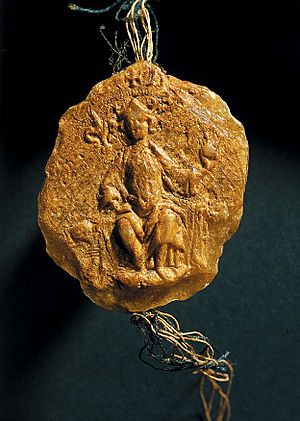Mindaugas facts for kids
Quick facts for kids Mindaugas |
|
|---|---|
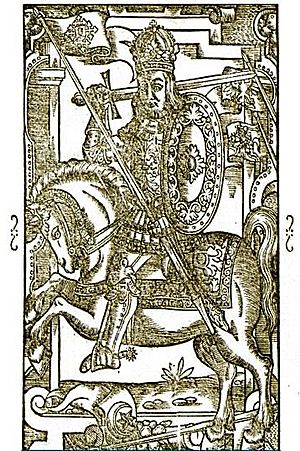
Mindaugas, as depicted in the chronicles of Alexander Guagnini
|
|
| King of Lithuania | |
| Reign | 1253–1263 |
| Coronation | 6 July 1253 |
| Grand Duke of Lithuania | |
| Reign | 1236–1253 |
| Successor | Treniota |
| Born | c. 1203 |
| Died | Autumn 1263 |
| Spouse | NN, sister of Morta Morta |
| Issue | NN daughter Vaišvilkas Ruklys Rupeikis |
| House | House of Mindaugas |
Mindaugas (born around 1203, died 1263) was a very important leader in the history of Lithuania. He was the first known Grand Duke of Lithuania. He was also the only person to be crowned King of Lithuania.
Not much is known about his early life or how he became powerful. He is first mentioned in a treaty from 1219 as an important duke. By 1236, he was seen as the main leader of all Lithuanians. He became powerful by making smart marriages and sometimes by removing or even killing his rivals.
During the 1230s and 1240s, Mindaugas expanded his lands to the southeast of Lithuania proper. Around 1250 or 1251, he decided to become a Roman Catholic. This helped him make an alliance with the Livonian Order, who had been enemies of the Lithuanians for a long time. In the summer of 1253, he was crowned King of Lithuania. He ruled over many people, perhaps between 300,000 and 400,000 subjects.
Mindaugas ruled as king for ten years. During this time, he achieved many things for his country. However, he still faced conflicts with his relatives and other dukes. The western part of Lithuania, called Samogitia, strongly resisted his rule. His gains in the southeast were also challenged by the Tatars. In 1261, he broke his peace with the Livonian Order. He might have even stopped being a Christian. In 1263, he was killed by his nephew Treniota and another rival, Duke Daumantas of Pskov. The next three rulers after him were also killed. Lithuania remained in chaos until Traidenis became Grand Duke around 1270.
For a long time, Mindaugas's reputation was not clear. But in the 19th and 20th centuries, he became much more respected. He is remembered as the only King of Lithuania. Other Lithuanian Grand Dukes, like Jogaila, also became Kings of Poland, but those were separate titles. Today, Mindaugas is generally seen as the founder of the modern Lithuanian state. He is also credited with stopping the Tatars from moving towards the Baltic Sea. He helped Lithuania gain international recognition and connect with Western Europe. In the 1990s, historian Edvardas Gudavičius found evidence for his exact coronation date: 6 July 1253. This day is now a national holiday in Lithuania, called Statehood Day.
Contents
Mindaugas's Life and Family
It's hard to find much information about Mindaugas from his time. Most of what we know comes from the Livonian Rhymed Chronicle and the Hypatian Codex. These books were written by groups who were often enemies of Lithuania. This means they might not always be fair to Mindaugas. Also, they often don't include dates or places for important events. For example, the Livonian Rhymed Chronicle spent 125 lines describing Mindaugas's coronation but didn't say when or where it happened.
Other important sources are official letters from the Pope about Mindaugas's baptism and crowning. The Lithuanians themselves didn't keep many written records from this time. Because of this lack of information, some questions about Mindaugas's life remain unanswered.
Since there are few old records, Mindaugas's family tree isn't fully known. Some later stories, like those from the 16th and 17th centuries, are not considered accurate. They claimed he came from a Roman noble family, which is likely not true. His birth year is often given as around 1203, but it's not certain. The Livonian Rhymed Chronicle mentions his father as a powerful duke but doesn't name him. Later stories call his father Ryngold.
Mindaugas had a brother named Dausprungas. Dausprungas's sons, Tautvilas and Gedvydas, were Mindaugas's nephews. Mindaugas is also thought to have had two sisters. One married Vykintas, and the other married Daniel of Halych. Vykintas and his son Treniota played big roles in later power struggles.
Mindaugas had at least two wives: Morta and Morta's sister, whose name is unknown. He might have had an earlier wife too. This is because two of his children – a son named Vaišvilkas and a daughter who married Svarn in 1255 – were already grown up when Morta's children were still young. Besides Vaišvilkas and his daughter, Mindaugas had two other sons, Ruklys and Rupeikis. These two sons were killed along with Mindaugas.
In the 13th century, Lithuania didn't have much contact with other countries. Lithuanian names sounded strange to foreign writers, who often changed them. Mindaugas's name was written in many ways, like Mindowe in Latin or Mendog in Polish. Historians believe his original Lithuanian name was Mindaugas. This name is very old and means something like "much wisdom" or "much fame."
How Mindaugas Became Powerful
In the early 13th century, Lithuania was made up of many small areas ruled by different dukes and princes. They were connected by their religion, traditions, trade, and family ties. They also sometimes fought together against common enemies.
Around the 12th century, merchants and missionaries from Western Europe started trying to control the area. They founded the city of Riga, Latvia, in 1201. Their efforts in Lithuania were stopped for a while after they lost the Battle of Saule in 1236. However, Christian military groups still posed a threat. The country also faced attacks from the Mongol Empire.
A treaty signed in 1219 with Galicia–Volhynia is often seen as the first clear sign that the Baltic tribes were uniting against these threats. This treaty was signed by twenty Lithuanian dukes and one duchess. It said that five of these dukes were older and more important. Mindaugas, even though he was young, was listed among these important dukes. This suggests he had inherited his title.
By 1236, the Livonian Rhymed Chronicle described him as the ruler of all Lithuania. It's not clear exactly how he gained this title. Some old records say he killed or forced out several other dukes, including some of his relatives. Historians believe he became powerful through a mix of marriages, military victories, and removing his rivals. Mindaugas understood that becoming Christian could help him get support from foreign merchants and the Teutonic Order. So, in 1251, he was baptized as a Catholic. This was mainly for political reasons, to gain allies in Catholic Europe. He was known to still worship his old gods even after his conversion.
During the 1230s and 1240s, Mindaugas made his power stronger in different Baltic and Slavic lands. Fighting in the region grew more intense. He fought German forces in Kurland. The Mongols also attacked, destroying Kiev in 1240 and entering Poland in 1241. The Lithuanian victory at the Battle of Saule helped stabilize the northern border for a short time. But Christian groups continued to gain land along the Baltic coast, founding the city of Klaipėda.
Since he was limited in the north and west, Mindaugas moved east and southeast. He conquered cities like Navahrudak, Hrodna, and Vawkavysk. Around 1239, he put his son Vaišvilkas in charge of these areas, which were called Black Ruthenia. In 1248, he sent his nephews Tautvilas and Edivydas, along with Vykintas, the Duke of Samogitia, to conquer Smolensk. But they failed. In 1249, a civil war started when Mindaugas tried to take lands from his nephews and Vykintas.
Becoming King: The Coronation
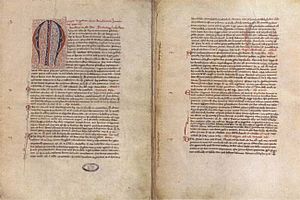
Tautvilas, Edivydas, and Vykintas formed a strong group against Mindaugas. They were joined by the people of Samogitia (western Lithuania), the Livonian Order, and Daniel of Galicia. The princes of Galicia managed to take control of Black Ruthenia, which weakened Mindaugas's son Vaišvilkas. Tautvilas made his position stronger by going to Riga and getting baptized by the Archbishop.
In 1250, the Livonian Order launched a big attack into Mindaugas's lands. Mindaugas was in a very difficult spot, attacked from different sides. But he was smart. He used the disagreements between the Livonian Order and the Archbishop of Riga to his advantage. He gave "many gifts" to the Order's leader, Andreas von Stierland, who was still angry at Vykintas for the defeat at the Battle of Saule in 1236.
In 1250 or 1251, Mindaugas agreed to be baptized. He also agreed to give up some lands in western Lithuania. In return, Pope Innocent IV agreed to recognize him as king. The Pope wanted a Christian Lithuania to help protect against Mongol threats. Mindaugas, in turn, wanted the Pope to help him with his conflicts against the Christian military orders.
On 17 July 1251, the Pope signed two important letters. One ordered the Bishop of Chełmno to crown Mindaugas as King of Lithuania. It also said a bishop should be appointed for Lithuania and a cathedral built. The other letter said the new bishop would report directly to the Holy See (the Pope), not to the Archbishop of Riga. This independence was good for Lithuania.
The exact date Mindaugas was baptized is not known. His wife, two sons, and people from his court were also baptized. The Pope later wrote that many of Mindaugas's subjects also became Christian.
The process of crowning him and setting up Christian organizations took two years. Conflicts continued during this time. In 1251, Tautvilas and his allies attacked Mindaugas's warriors at Voruta Castle. The attack failed, and Tautvilas's forces had to retreat. Vykintas died in 1251 or 1252, and Tautvilas had to join Daniel of Galicia.
The Kingdom of Lithuania
| Mindaugas's gifts of land to the Livonian Order |
|
|---|---|
| Date | Territory |
| July 1253 | Parts of Samogitia (half of Raseiniai, Betygala, Ariogala, and Laukuva – the other half went to Bishop Christian in March 1254), half of Dainava and Nadruva |
| October 1255 | Selonia |
| 1257 | Karšuva, Nadruva, parts of Samogitia |
| 7 August 1259 | Parts of Dainava, all of Skalva and Samogitia |
| June 1260 | All of Lithuania (if Mindaugas died without an heir) |
| 7 August 1261 | All of Selonia |
Mindaugas and his wife Morta were crowned king and queen in the summer of 1253. Bishop Henry Heidenreich of Kulm led the church ceremonies. Today, 6 July is celebrated as Statehood Day in modern Lithuania. The exact date of the coronation is still debated by historians. The location of the crowning is also unknown.
Lithuania enjoyed about eight years of peace and stability. Mindaugas used this time to expand his lands to the east. He also worked on setting up government systems. He made his power stronger in Black Ruthenia, Polatsk (a major trade center), and Pinsk. He also made peace with Galicia–Volhynia and married his daughter to Svarn, the son of Daniel of Galicia. Svarn later became Grand Duke of Lithuania.
Lithuania's relationships with Western Europe and the Holy See (the Pope) became stronger. In 1255, Mindaugas even got permission from Pope Alexander IV to crown his son as King of Lithuania. He started a noble court, an administration system, and a diplomatic service. Silver coins were made, which showed that Lithuania was becoming a proper state. He also supported building a cathedral in Vilnius, possibly where Vilnius Cathedral stands today.
Right after his coronation, Mindaugas gave some lands to the Livonian Order. These included parts of Samogitia, Nadruva, and Dainava. However, his control over these western lands was not very strong. Historians have discussed whether Mindaugas gave even more lands to the Order later (between 1255 and 1261). Some believe the documents for these gifts might have been faked by the Order. This idea is supported because some documents mention lands Mindaugas didn't actually control.
Mindaugas and his rival Daniel made peace in 1255. The Black Ruthenian lands were given to Roman, Daniel's son. After this, Mindaugas's son Vaišvilkas became a monk in the Orthodox faith. He later founded a convent and monastery. Tautvilas's conflict with Mindaugas ended for a while when he accepted Mindaugas as his superior and received Polatsk as his own land.
A direct fight with the Mongols happened in 1258 or 1259. Berke Khan sent his general Burundai to challenge Lithuanian rule. The Novgorod Chronicle says the Lithuanians were defeated, but some historians see it as a gain for Mindaugas.

An old record mentions Mindaugas defending himself in Voruta against his nephews and Duke Vykintas. Other sources also mention "his castle." The exact location of Voruta is not known, which has led to much discussion and archaeological research. At least fourteen places have been suggested, including Kernavė and Vilnius. Archaeological digs at Kernavė started in 1979 after a part of the site called "Mindaugas Throne hill-fort" collapsed. Today, Kernavė hosts a big celebration on Statehood Day.
Assassination and What Happened Next
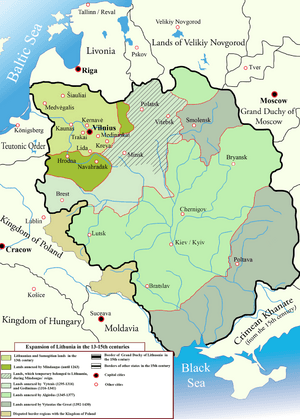
The Livonian Order used their alliance with Mindaugas to gain control over Samogitian lands. In 1252, Mindaugas approved the Order building Klaipeda Castle. However, the Order's rule was seen as harsh. Local merchants could only do business through people approved by the Order. Inheritance laws were changed, and people's choices about who to marry and where to live were limited. This led to several battles.
In 1259, the Order lost the Battle of Skuodas. In 1260, they lost the Battle of Durbe. The first defeat encouraged a rebellion by the Semigalians. The defeat at Durbe led the Prussians to start the Great Prussian Rebellion, which lasted 14 years.
Seeing these events, and encouraged by his nephew Treniota, Mindaugas broke his peace with the Livonian Order. The benefits he expected from becoming Christian had turned out to be small.
Mindaugas might have gone back to his old pagan religion after this. Many historians believe his conversion was only a strategy. Evidence for him returning to paganism comes from two sources. One is a statement from Pope John XXII in 1324 saying Mindaugas had "returned to error." The other is the Galician–Volhynian Chronicle. This chronicle says Mindaugas continued to practice paganism, making sacrifices to his gods and performing pagan rites in public. However, historians note that this account might be biased because Mindaugas was at war with Volhynia. On the other hand, Pope Clement IV wrote in 1268 about "Mindaugas of happy memory," regretting his murder.
In any case, the Lithuanians were not ready to accept Christianity. Mindaugas's baptism didn't have a big impact on the country's development. Most of the people and nobles remained pagan. His subjects were not forced to convert. The cathedral he built in Vilnius was later replaced by a pagan temple. All the diplomatic achievements made after his coronation were lost. However, Christianity and intermarriage were generally tolerated.
Regional conflicts with the Order grew worse. Alexander Nevsky of Novgorod, Tautvilas, and Tautvilas's son Constantine agreed to form a group against Mindaugas, but their plans failed. Treniota became the leader of the Samogitian resistance. He led an army to Cēsis (in modern Latvia) and fought in Masovia (in modern Poland). His goal was to encourage all the conquered Baltic tribes to rise up against the Christian orders and unite under Lithuanian leadership.
Treniota's influence grew while Mindaugas focused on conquering lands in Ruthenia. Mindaugas sent a large army to Bryansk. Treniota and Mindaugas started to have different goals. The Rhymed Chronicle mentions Mindaugas's unhappiness that Treniota didn't make any alliances in Latvia or Estonia. Mindaugas might have started to prefer diplomacy.
During these events, his wife Morta died. Mindaugas then married her sister. The problem was that her sister was already married to Daumantas. In revenge, Daumantas and Treniota killed Mindaugas and two of his sons in the fall of 1263. An old story says the killing happened in Aglona. Mindaugas was buried with his horses, following old traditions.
After Mindaugas's death, Lithuania fell into internal disorder. Three of his successors—Treniota, his son-in-law Svarn, and his son Vaišvilkas—were killed in the next seven years. Stability did not return until Traidenis became Grand Duke around 1270.
Mindaugas's Legacy
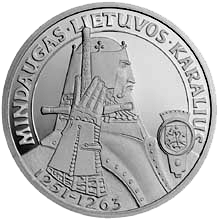
Mindaugas's place in Lithuanian history was unclear until the Lithuanian national revival in the 19th century. People who supported paganism didn't like him because they felt he betrayed his religion. Christians thought his support for their faith was not strong enough.
He was only briefly mentioned by Grand Duke Gediminas and not at all by Vytautas the Great. His known family connections end with his children. There are no historical records linking his descendants to the Gediminids dynasty, which ruled Lithuania and Poland until 1572.
A university leader in Vilnius in the 17th century blamed Mindaugas for the problems of the Polish–Lithuanian Commonwealth. He said Mindaugas had "sown the seeds of internal discord among the Lithuanians." A 20th-century historian even blamed him for the "destruction of the organization of the Lithuanian state."
The first academic study of his life by a Lithuanian scholar, Jonas Totoraitis, was not published until 1905. In the 1990s, historian Edvardas Gudavičius found the exact date of his coronation, which then became a national holiday. In 2003, the 750th anniversary of his coronation was celebrated. A bridge in Vilnius, the Mindaugas Bridge, was named after him. There were many festivals and concerts, and leaders from other countries visited.
In Belarus, there is a legendary place called Mindaugas's Hill in Navahrudak. It was mentioned by Adam Mickiewicz in his 1828 poem Konrad Wallenrod. A memorial stone was placed on Mindaugas's hill in 1993, and a metal sculpture of Mindaugas in 2014.
Mindaugas is the main character in the 1829 play Mindowe by Juliusz Słowacki. He has also been shown in several books and plays in the 20th century. These include the Latvian play Vara (Power, 1944) by Mārtiņš Zīverts, the Lithuanian play Mindaugas (1968) by Justinas Marcinkevičius, and the novel Alhierd's Lance (2002) by Volha Ipatava.
See also
 In Spanish: Mindaugas para niños
In Spanish: Mindaugas para niños
- History of Lithuania (1219–1295)
- List of rulers of Lithuania
- Early dukes of Lithuania




